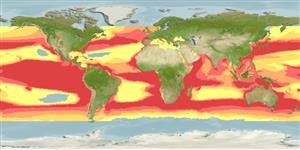Elasmobranchii (Haie und Rochen) (sharks and rays) >
Carcharhiniformes (Ground sharks) >
Sphyrnidae (Hammerhead, bonnethead, or scoophead sharks)
Etymology: Sphyrna: Probable misspelling of sphyra (Gr.), hammer, referring to their hammer-shaped heads. (See ETYFish); zygaena: zygaina, ancient Greek name for hammerhead sharks, derived from zygon, yoke, alluding to yoke-like shape of cephalofoil. (See ETYFish).
More on author: Linnaeus.
Environment: milieu / climate zone / depth range / distribution range
Ökologie
seewasser; brackwasser; ozeanodrom (Ref. 13562); tiefenbereich 0 - 200 m (Ref. 5578), usually 0 - 20 m (Ref. 55303). Subtropical; 59°N - 55°S, 180°W - 180°E
Widespread in temperate and tropical seas (Ref. 13562). Western Atlantic: Canada to the Virgin Islands; Brazil to Argentina. Eastern Atlantic: British Isles to Côte d'Ivoire, including the Mediterranean. Indo-Pacific: South Africa to Sri Lanka; southern Siberia to Viet Nam (Ref. 13562); southern Australia, New Zealand, and Hawaii (Ref. 13562). Eastern Pacific: northern California, USA to Chile.
Length at first maturity / Size / Gewicht / Alter
Maturity: Lm 250.0, range 265 - ? cm
Max length : 500 cm TL Männchen/unbestimmt; (Ref. 35388); common length : 335 cm TL Männchen/unbestimmt; (Ref. 13562); max. veröff. Gewicht: 400.0 kg (Ref. 9987); max. veröff. Alter: 21 Jahre (Ref. 116211)
Rückenflossenstacheln (insgesamt): 0; Rückenflossenweichstrahlen (insgesamt): 0; Afterflossenstacheln 0; Afterflossenweichstrahlen: 0. A large hammerhead without a notch at the center of the curved headhead (Ref. 58085); but with prominent lateral indentations; prenarial grooves well-developed; snout short, 1/5 to less than a third of head width; mouth broadly arched (Ref. 114967); the first dorsal fin is moderately high, te second dorsal and pelvic fins are low. Colour olive-grey or dark grey above, white belowm, and the undersides of the pectoral fin tips dusky (Ref. 58085),
Occurs inshore and well offshore (Ref. 5578), over continental and insular shelves (Ref. 244). Coastal, pelagic, and semi-oceanic, but often bottom associated at 1-139 m (Ref. 58302). Migrates northward in summer; young often in large aggregations of hundreds of individuals (Ref. 13562). Prefers to feed on small sharks, skates and stingrays, but also preys on bony fishes, shrimps, crabs, barnacles and cephalopods (Ref. 244). Viviparous (Ref. 50449). Regarded as being dangerous to people, though only few can be tentatively attributed to this species due to its occurrence in temperate waters (Ref. 244). Reported to cause poisoning (Ref. 4690). Caught occasionally by shark and tuna longline fisheries (Ref.58048). Meat utilized fresh, dried-salted, and possibly smoked for human consumption; liver oil for vitamins, fins for soup, hide for leather, and carcasses for fishmeal (Ref. 244). Used in Chinese medicine (Ref. 12166). Become sexually mature when 250 to 300 cm long. The female gives birth to 30 - 40 young (Ref. 35388).
Viviparous, placental (Ref. 50449), with 20 to 50 young per litter (Ref. 6871)after a gestation period of 10-11 months (Ref.58048). Size at birth between 50-60 cm TL (Ref. 13562).
Compagno, L.J.V., 1984. FAO Species Catalogue. Vol. 4. Sharks of the world. An annotated and illustrated catalogue of shark species known to date. Part 2 - Carcharhiniformes. FAO Fish. Synop. 125(4/2):251-655. Rome: FAO. (Ref. 244)
IUCN Rote Liste Status (Ref. 130435)
Nutzung durch Menschen
Fischereien: kommerziell; Sportfisch: ja
Mehr Information
ReferenzenAquakulturAquakultur ProfilZuchtlinienGenetikElectrophoresesVererbbarkeitKrankheitenVerarbeitungNutrientsMass conversion
Tools
Zusatzinformationen
Download XML
Internet Quellen
Estimates based on models
Preferred temperature (Ref.
123201): 11.8 - 28.9, mean 26.5 °C (based on 3124 cells).
Phylogenetic diversity index (Ref.
82804): PD
50 = 0.5029 [Uniqueness, from 0.5 = low to 2.0 = high].
Bayesian length-weight: a=0.00398 (0.00298 - 0.00532), b=3.08 (3.00 - 3.16), in cm total length, based on LWR estimates for this species (Ref.
93245).
Trophic level (Ref.
69278): 4.9 ±0.5 se; based on diet studies.
Generation time: 11.0 ( na - na) years. Estimated as median ln(3)/K based on 2
growth studies.
Widerstandsfähigkeit (Ref.
120179): niedrig, Verdopplung der Population dauert 4,5 - 14 Jahre. (tmax=21; tm=8.8; Fec=20-40).
Prior r = 0.28, 95% CL = 0.16 - 0.49, Based on 1 stock assessment.
Fishing Vulnerability (Ref.
59153): High to very high vulnerability (68 of 100).
Climate Vulnerability (Ref.
125649): Moderate vulnerability (38 of 100).
Nutrients (Ref.
124155): Calcium = 6.91 [1.40, 36.90] mg/100g; Iron = 0.597 [0.147, 1.835] mg/100g; Protein = 21 [19, 23] %; Omega3 = 0.181 [0.072, 0.443] g/100g; Selenium = 28.1 [9.1, 75.6] μg/100g; VitaminA = 6.26 [1.94, 20.86] μg/100g; Zinc = 0.362 [0.178, 0.681] mg/100g (wet weight);
